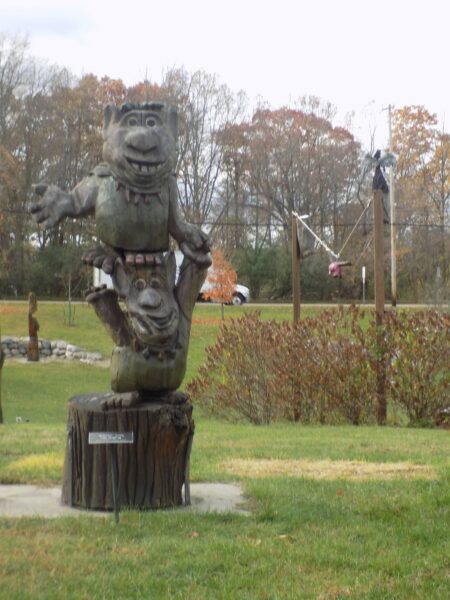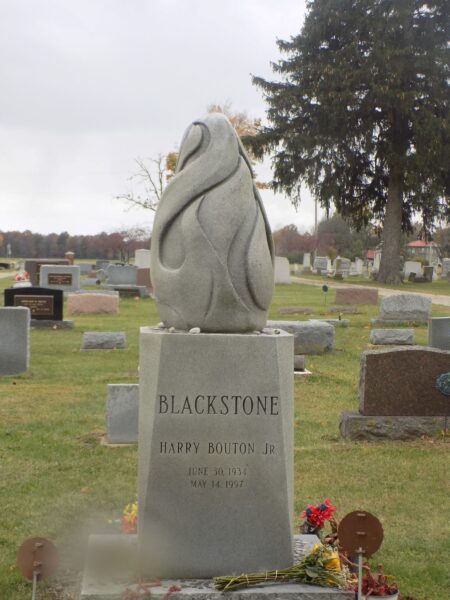You might recognize the title of today’s entry from the famous Robert Burns poem To a Mouse – “The best laid schemes o’ mice an’ men / Gang aft a-gley” and it seems to be an appropriate theme for this trip given the closures I’d faced thus far. Wednesday morning my best laid schemes continued going astray.
Let’s start with the easy one. You may recall that one of the reasons I chose to stay three nights in Battle Creek sprung from the complication created by both Michigan and Michigan State having home football games scheduled for the coming Saturday – a circumstance that rendered rooms scare and expensive in and around both Ann Arbor and East Lansing. Battle Creek is about an hour’s drive from East Lansing where I expected to see a volleyball game Friday night. It’s also close to a number of places of interest and has one, in particular, of its own – the Adventist Village. It’s closed one day during the week and if you guessed that one day is Wednesday, treat yourself to a prize.
I don’t know how but it did.
Sometime early Wednesday morning I dropped my phone. When I picked it up, it looked like this:

Fortunately, there was a phone repair shop within walking distance of the hotel. Unfortunately, the torn strip on the right meant it could only be repaired by replacing the screen. Fortunately, that’s neither a costly nor lengthy repair. Unfortunately, because it was a T-Mobile branded phone, no one stocks the part and I was told it required 24-48 hours before it could be delivered. Fortunately, there was also a T-Mobile store within walking distance of both the repair shop and the hotel and, although they couldn’t repair my phone, they could replace it.
The store didn’t open until 10:00 and there were only two employees to serve four customers. By the time we navigated through the maze of purchasing the phone, transferring the SIM card, retrieving saved data, and the like, it was well past 11:00. The late start necessitated more changes to my hoped for Wednesday activities.
A fantastical first stop.
With my new phone set up and working, I opened up a maps app and set off to the Leila Arboretum established when Leila Post Montgomery made a gift of 72 acres of land to Battle Creek in 1922. Although the arboretum’s design was completed in 1924, the project itself wasn’t completed until the 1970s.
The arboretum’s design incorporated a grove of century old ash trees that were decimated in the 21st century by the arrival of the emerald ash borer. The community suggested creating a sculpture garden from the remains of the dead trees and local school children prompted the fantasy theme. The first trees were shaped by Michigan artists in June 2015 and the display expanded the following year.
Entering the space, one is greeted by the Welcome Trolls.

Among my favorite works was this one called “The Strange Disappearance of Ole MacDonald.”

There had been a mixture of snow and frost overnight and although it was quite late in the morning, enough of a chill remained that I didn’t linger too long before setting off for my next destination.
The magic town of Colon.
The tiny town of Colon, Michigan (fewer than 1,500 people live within its 1.737 square miles) sits about 32 miles south of Battle Creek, six or seven miles north of the Michigan – Indiana border, and bills itself as the “Magic Capital of the World”. This seems to be a bold declaration for a small, relatively isolated place. However, according several sources, not only has the city made this declaration, but sometime in the 1990s so did the U.S. Congress.
To discover how this came to pass we need to look back nearly a century to 1925 when Harry Blackstone (often called The Great Blackstone) made Colon (Pronounced Coe-lynn) his summer home and the place where he and his brother Pete Bouton refurbished old tricks and created new ones in preparation for the next year’s shows. But the real magic began in 1927 when Blackstone invited Australian magician Percy Abbott to join him.
Abbott joined with Blackstone to form the Blackstone Magic Company.

(From abbottmagic.com).
Their partnership lasted a few years until Abbott mistakenly sent another magician the implements for an illusion that Blackstone considered proprietary. Their partnership dissolved and their rift never fully mended.
In 1934, Abbott, having settled in Colon and having become a new parent, opened the Abbott Magic Company. He was joined shortly thereafter by Recil Bordner. In 1934, they held an open house for magicians that became the first Magic Get Together in Colon. It would be Lester Lake (AKA The Great Marvello) who first declared Colon’s magic capital status.
According to the history on the company’s website,
During World War 2, Abbott’s was given “Vital Industry” status since it supplied soldiers books on sleight of hand for recreation. Abbott’s printed these books on their own print shop in the basement which allowed them to make these books to the exact size to fit in a soldiers (sic) pocket. The “Vital Industry” status allowed Abbotts to purchase surplus and scrap metal to continue manufacturing magic products during the war years.
After the war ended and the soldiers returned home, business began to boom for the two partners and they opened up branch retail shops in New York, Los Angeles, Detroit, Chicago, Boston, and Indianapolis. Abbotts magic factory in Colon was expanded during this time to meet the new demands of these new shops and the post war populace.
and this status no doubt played a role in the company’s stability and success.
I met Greg Bordner, Recil’s son on my visit there. Greg has been with the business for nearly half a century. We had a lengthy and engaging conversation that stretched over an unexpected range of topics. In addition to its magic capital title, another reason I wanted to go to Colon was to visit the Lakeside Cemetery because no fewer than 28 illusionists are buried there.
I told Greg that I’d read somewhere that he had a one-sheet handout marking the various gravesites. Apparently, this wasn’t entirely accurate but he generously gave me a small book called DECADES – Abbott Magic that did contain such a guide. He directed me the cemetery and to Blackstone’s grave.

Unfortunately, because I had one more stop I’d hoped to make this Wednesday and had spent more time with Greg than I’d anticipated, I had to rush out of the cemetery without paying homage to any of the other magicians there interred. Once again, my schedule had gang a-gley.
On to Marshall.
I’d need about 45 minutes to drive from Colon to Marshall where I hoped to visit the American Museum of Magic. Fortunately, this museum is closed Monday and Tuesday making a Wednesday visit possible. Unfortunately, it’s only open until 16:00 on the other days and it was 14:30 or so when I left the cemetery.
The GPS predicted my arrival time accurately leaving me about 45 minutes to go through the exhibitions. (Here I need to say a few words about the GPS. When writing about my trip through the Western U.S. in 2017, I suggested having a paper map because I found long stretches of highway where I had no connection. In the six years since, coverage has expanded and apps like Organic Maps that have offline capability have changed that scenario. Since many of the places I visited on this trip could be described as at least somewhat out of the way, I think it would have been exceptionally difficult to duplicate with old style paper maps or no one to serve as navigator.
And while I’m at it, I’ll also remark about how much I liked the convex blind spot detection mirror on my Hyundai Elantra rental and a feature called Android Auto that used a USB to connect my phone to both the main display screen – great for maps – and audio.)
Now, back to the American Museum of Magic. Given the nature of the way magic shows were historically promoted, it makes sense that the predominant artifacts in the museum are posters like this one:

(Notice Blackstone promises 30 MOSTLY Gorgeous GIRLS. And no, I can’t tell you if being mostly gorgeous is in some way related to being mostly dead.) In addition to the plethora of posters, there are other historical objects and the lone employee who was there was helpful in guiding me through the first floor. I’d rate the museum worth a stop if you’re in the area but not necessarily worth a detour. Unless, of course, you think that if it’s magic, it will fill you up without a bite and quench your every thirst. If that’s the case, then by all means make the detour.
You can see some of those posters and objects together with other photos from the day here.